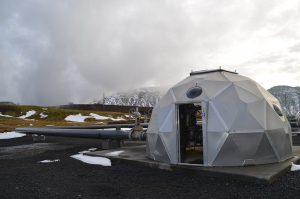We all know putting too much carbon dioxide in the air poses a huge problem for our planet. But we also have an undying thirst for energy that keeps power plants around the world pumping it out in endless plumes.
Now one group of researchers have found a way to halt this trend by trapping CO2 emissions in the most novel way possible. They’ve buried it back into the Earth and turned it into harmless stone. The process itself isn’t new but what’s astounding is that it only took two years. Previous studies estimated the transformation could take hundreds of years at a minimum. That’s some speed up! And it brings exciting new hopes in the struggle to combat climate change.

Dubbed the Carbfix project, the study took place at Iceland’s Hellisheidi power plant near Reykjavik starting in 2012. Scientists working at the country’s largest geothermal facility mixed its emissions with water and injected the fluid 400-800 metres deep into a layer of basalt rock.
The highly reactive basalt turned the CO2 mix into a fizzy liquid that eventually dried into chalky veins. And in the two years it took to solidify, researchers confirmed only 5% of the injected emissions escaped out of the rock – a remarkably low rate which should help alleviate fears of leakage and nearby water contamination that are typical of this storage process.
“We need to deal with rising carbon emissions. This is the ultimate permanent storage – turn them back to stone,” said Juerg Matter, who led the research published in the journal Science.
But in case you thought all the world’s power plants could start capturing their carbon emissions tomorrow, don’t get your hopes up too high yet.
Iceland has an unusually large amount of basalt rock to work with because it’s a volcanic island. With the exception of a few inland locations, most of the world’s basalt deposits are actually buried in the oceans’ seafloors. This means the carbon capture process would work best for power plants located near coastlines.
And the project doesn’t come cheap. So far, the Carbfix project has racked up $10 million in costs. We’d need to implement incentives like a carbon emissions tax if we’re going to convince power plants to loosen their purse strings for this cause.
Still, the UN’s Intergovernmental Panel on Climate Change made it clear carbon capture and storage is vital to stopping global warming. The IPCC estimates the cost of halting global warming would double if we don’t implement this solution. Along with pursuing alternative energy sources, we should look at capturing carbon emissions as part of a diversified approach at reducing mankind’s global carbon footprint.











